IELTS Writing Tracks – from the video of Simon
Table of Contents
Bad news: I will take exam on Sunday, excatly, the day after tomorrow.
1. For Part One Writing
NOTED that the only thing you should do is to describe the graph, no conclusion or any related stuff.
1.1. Structure
Four paragraphs recommanded:
- Introduction: just rephrasing the introduction in the question
- Overview: Give the overview, which is thorough, and key points you want to mention. Make a general comparison, a summary.
- Details 1: blablabla
Details 2: blablabla
Noted that: no conclusion.
1.2. Line Graph
I will show you an example.
1.2.1. Example
The question is:
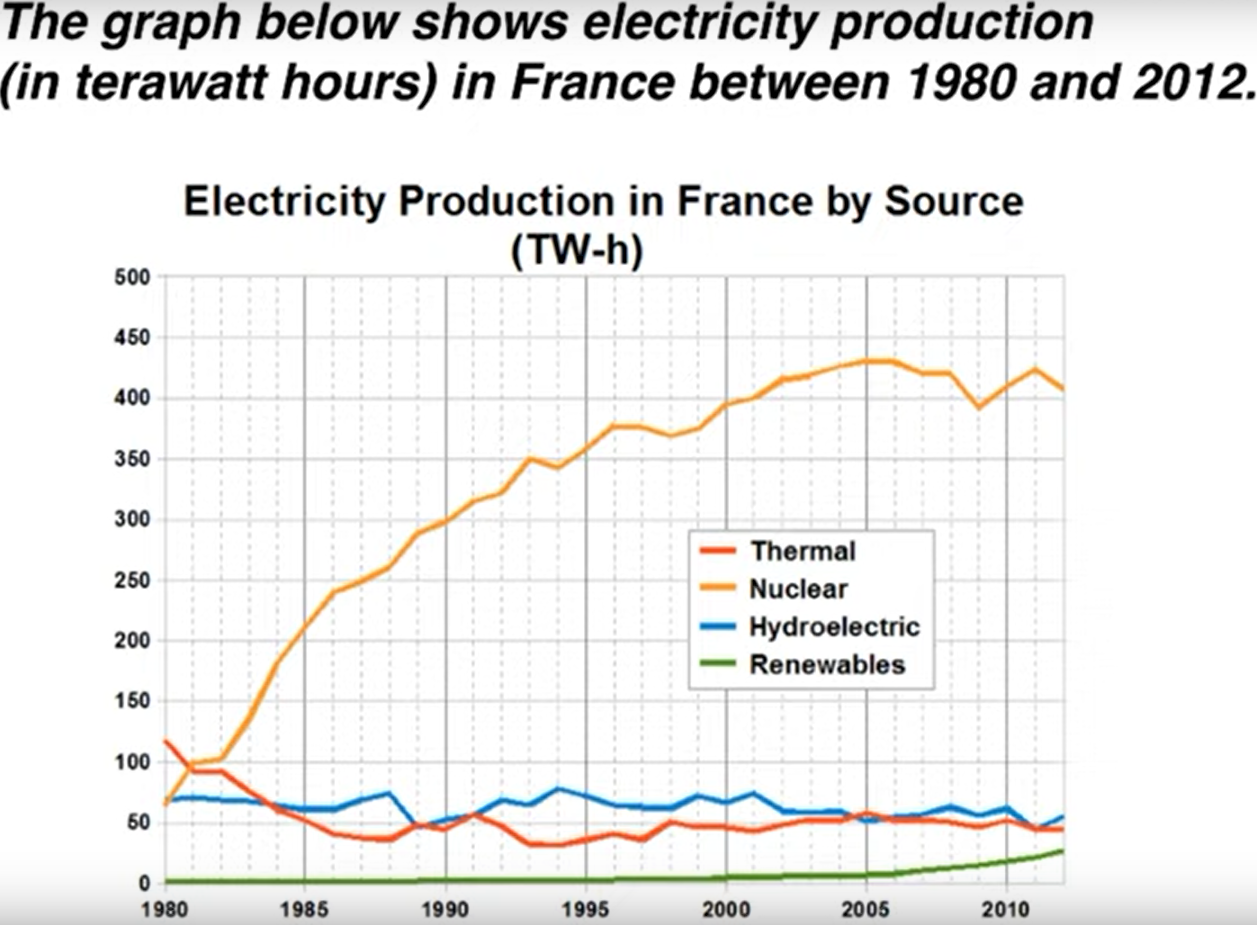
The writing is:
The line graph compares the amount of electricity produced in France using four different sources of power over a period of 32 years.
It is clear that nuclear power was by far the most important means of electricity generation over the period show. Renewables provided the lowest amount of electricity in each year.
In 1980, thermal power stations were the main source of electricity in France, generating around 120 terawatt hours of power. Nuclear and hydroelectric power stations produced just under 75 terawatt hours of electricity each, and renewables provided a negligible amount. Just one year later, nuclear power overtook thermal power as the primary source of electricity.
Between 1980 and 2005, electricity production from nuclear power rose dramatically to a peak of 430 terawatt hours. By contrast, the figure for thermal power fell to only 50 terawatt hours in 1985, and remained at this level for the rest of the period. Hydroelectric power generation remained relatively stable, at between 50 and 80 terawatt hours, for the whole 32-year period, but renewable electricity production saw only a small rise to approximately 25 terawatt hours by 2012.
WARNING:
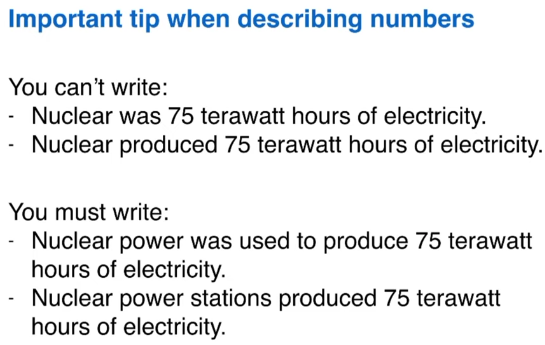
1.2.2. Vocabs
- Paragraph 1
- amount of XXX produced
- source of generating
- means of XXX generation
- over a period of XXX or over the period shown
- Paragraph 2
- by far the most important
- a negligible amount
- AAA overtook BBB
- as the primary source of XXX
- XXX rose dramatically to a peak of XXX
- by contrast
- the figure for XXX
- remained at this levvel, remained stable
- saw only a small rise or saw a increase of XXX
1.3. Bar Charts
Example question:
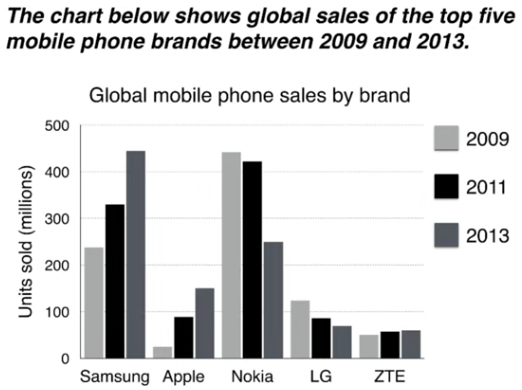
The bar chart compares the number of mobile phones sold worldwide by the five most popular manufactures in the years 2009, 2011, and 2013.
It is clear that Nokia sold the most mobile phones between 2009 and 2011, but Samsung became the best selling brand in 2013. Samsung and Apple saw the biggest rises in sales over the 5-year period.
In 2009, Nokia sold close to 450 million mobile phones, which was almost double the number of handsets sold by the second most successful manufactures, Samsung. Over the following four years, however, Nokia's sales figures fell by approximately 200 million units, whereas Samsung saw sales rise by a similar amount. By 2013, Samsung had become the market leader with sales reaching 450 million units.
The other three top selling mobile phone brands between 2009 and 2013 were LG, ZTE and Apple. In 2009, these companies sold around 125 million, 50 million and 25 million mobile handsets respectively, but Apple overtook the other two vendors in 2011. In 2013, purchases of Apple handsets reached 150 million units, while LG saw declining sales and the figures for ZTE rose only slightly.
1.4. Pie Charts
Example:
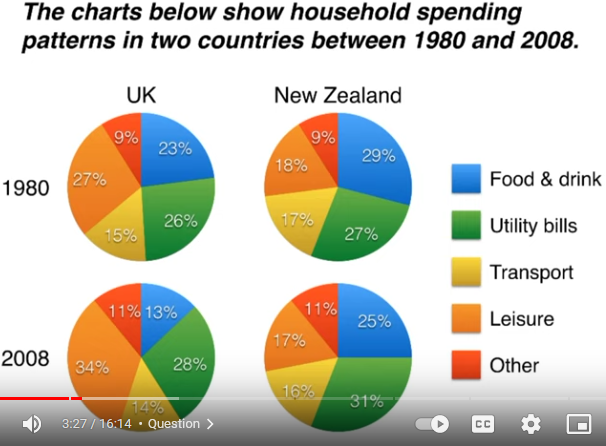
The pie charts compare five categories of household expenditure in the UK and New Zealand in the years 1980 and 2008.
It is noticeable that the proportion of spending on food and drink fell in both countries over the 28-year period, while spending on utility bills rose. Also, UK residents spent a significantly larger percentage of their household budgets on leisure than their New Zealand counterparts.
In 1980, 29% of an average New Zealand household budget went on food and drink, while the equivalent figure for a UK home was 23%. By 2008, expenditure on food and drink had fallen by 4% in New Zealand, and by a full 10% in the UK. By contrast, both countries saw an increase in expenditure on utility bills for the average home, form 27% to 31% in New Zealand and from 26% to 28% in the UK.
Leisure activities accounted for the highest proportion of UK household spending in both years, but only the third highest proportion in New Zealand. In fact, in 2008, New Zealanders spent only half as much in relative terms on recreation (17%) as UK residents (34%). In both countries, transport costs and other costs took roughly 15% and 10% of household budgets, respectively.
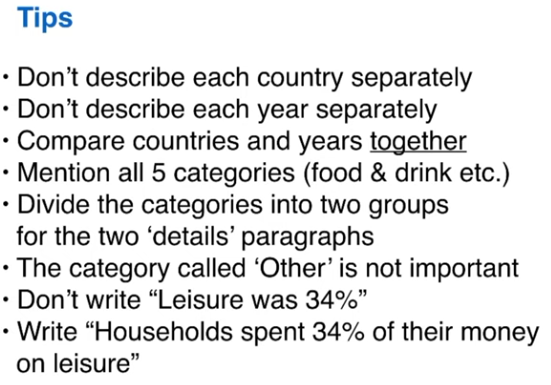
1.5. Tables
Example:
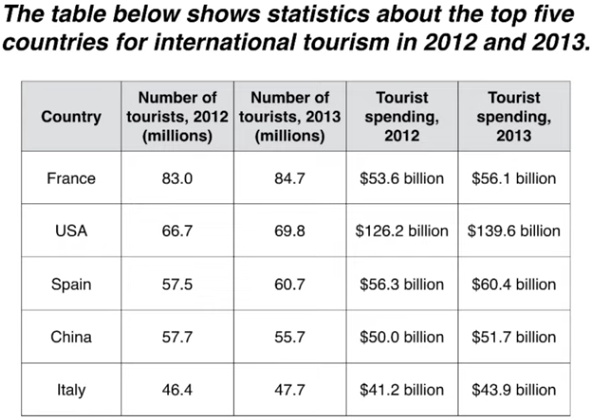
The table compares the five highest ranking countries in terms of the numbers of visits and the money spent by tourists over a period of two years.
It is clear that France was the world's most popular tourists destination in the years 2012 and 2013. However, the USA earned by far the most revenue from tourism over the same period.
In 2012, 83 milliion tourists visited France, and the USA was the second most visited country, with 66.7 million tourists. Spain and China each received just under 58 million visitors, while Italy was ranked fifth with 46.4 million tourists. 2013 saw a rise of between 1 and 4 million tourist visits to each country, with the exception of China, which received 2 million fewer visitors than in the previous year.
Spending by tourists visiting the USA increased from $126.2 billion in 2012 to $139.6 billion in 2013, and these figures were well over twice as high as those for any other country. Spain received the second highest amounts of tourist revenue, rising from $56.3 billion to $60.4 billion, followed by France, China, and Italy. Interestingly, despite falling numbers of tourists, Chinese revenue from tourism rose by $1.7 billion in 2013.
Note: You cannot mention all the numbers in the table.
1.6. Two different charts together
Solution: we can summerize the main feature of these two charts, as the introduction, and then describe the details of these two charts seperately, as paragraph 3 and paragraph 4.
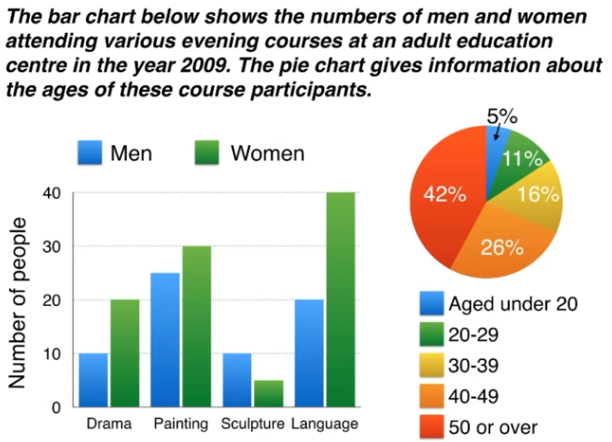
The bar chart compares the numbers of males and femails who took four different evening classes in 2009, and the pie chart shows the age profile of these attendees.
It is clear that significantly more women than men attended evening classes at the education centre. We can also see that evening courses were much more popular among older adults.
According to the bar chart, drama, painting and language courses all attracted more women than men to the education centre in 2009. Lnaguage classes had the highest number of participants overall, with 40 female and 20 male students, while painting was a popular choice among both genders, attracting 30 female and 25 male attendees. The only course with a higher number of males was sculpture, but this course was taken by a mere 15 people in total.
Looking at the age profile pie chart, we can see that the majority of people attending evening lessons were over 40 years of age. To be precise, 42% of them were aged 50 or more, and 26% were aged between 40 and 49. Yonger adults were in the minority, with only 11% of students aged 20 to 29, and only 5% aged under 20.
1.7. Process diagram
- Step Language
- At the first stage in the process
- The process begins with
- Secondly, Finally
- The second step involves
- Next, then, after that
- At the following stage
- passive verbs
- like "glass is collected" for "glass collection"
- sorting by hand: like "the collected glass is sorted by hand"
- Grinding machine: we donnot know the passive of griding, so we use"the glass is passed through a grinding machine."
Example:
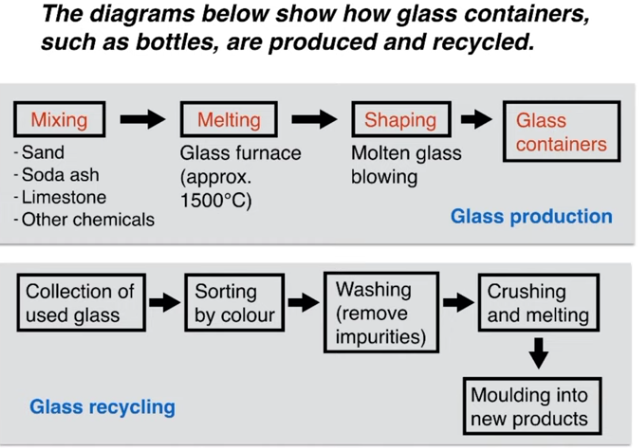
The first flow diagram illustrates the process of glass container production, and the second diagram shows steps in the process of recycling used glass.
We can see that glass is made using three main raw materials, and that the manufacturing process consists of four distinct stages. It requires five steps to turn used glass into new glass products.
At the first stage in the production of glass, sand, soda ash, limestone and other chemicals are mixed together. Next, this mixture is heated in a glass furnace at approximately 1500oC to produce molten glass. The molten glass can then be shaped, by blowing, to create the end products, namely glass containers.
Glass recycling begins with the collection of used glass products. The collected glass is sorted according to its colour, and then washed in order to remove any impurities. At the fourth stage of recycling, the glass is crushed and melted, and the resulting molten glass can finally be moduled to create new items.
1.8. comparison diagrams
- MAP: before and after diagram
- two alternative diagrams
compare and select a location
Just compare the diagrams, by:
- describe the changes
- and things not changed
- and differences
- and similarities
Example:
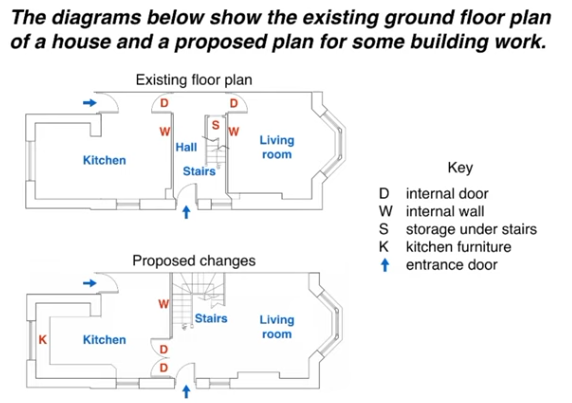
The two pictures compare the current layout of the ground floor of a house with a plan to redesign the same living space.
We can see that the new design proposal involves making a number of changes to the ground floor of the house, mainly in the central hall area. There are no plans to change the external walls or entrances.
The most noticeable change from the existing to the proposed floor plan is that there will no longer be a separate hall area when the building work has been done. This will be achieved by removing the internal wall and door between the hall and living room, along with the current staircase and under-stair storage cupboard. With no separate hall area, the proposed living room will also contain the staircase to the first floor.
To replace the current straight staircase, a new set of winding stairs will be installed in the corner of the living room. The internal door between the hall and kitchen will also be replaced with the new living room. Finally, the planned building work will also include the installation of some kitchen furniture.
2. Part Two Writing
40 minutes, no less than 250 words.
scoring criteria:
- response or not
- coherence
- vocabulary
- grammar (do not think so.)
250 words in 4 paragraphs with 13 sentences:
- introduction with 2 sentences
- two main paragraphs, each paragraphs with 5 sentences.
conclusion: 1 sentence only.
You should take 10 minutes to plan the essay.
2.1. Introduction
- sentence 1: introduce the topic
- sentence 2: give the general answer
There are several introduction writing examples:
2.1.1. discussion

People have different views about the effectiveness of group study as opposed to working alone. While there are some benefits to studying indepently, I believe that group work is usually more productive.
2.1.2. Opinion

It is sometimes argued that school students should be made to do some work in their local communities. In my opinion, it would be wrong to force teenagers to do any kind of unsalaried work. (or: I completely agree that this kind of scheme would be a good idea.)
2.1.3. Problem & Solution

It is true that punishments do not always deter criminals from committing more crimes. There are various reasons why offenders repeatedly break the law, but governments could certainly take steps to address this issue.
2.1.4. Two part question

Work plays a central role in our lives, and we would all like to feel fulfilled professionally. While a variety of factors may lead to job satisfaction, it would be unrealistic to expect everyone to be happy at work.
2.2. Paragraph 2 and 3
Paradigram:
2.2.1. firstly, secondly, finally: advantages, disadvantages, problems, solutions
take the example in introudction

There are several reasons why I would argue against having compulsory community service for secondary school students. Firstly, the school curriculum is already full with important academic subjects, such as maths, science and languages. For example, I remember having an extremely busy timetable when I was at high school, and it would not have been possible to add to it. Secondly, students’ performance in other subjects would be affected if valuable study time were taken by charity work or neighbourhood improvement schemes. Finally, I believe that teenage students would be reluctant to take part in any programme of obligatory work, and this could lead to poor motivation and even bad behaviour.
2.2.2. Idea, Explain, Example: one idea, a reason, an opinion
On the other hand, the opportunity to do voluntary community service could be extremely positive for high school students. By making these programmes optional, schools would ensure that only motivated students took part. These young people would gain valuable experience in an adult working environment, which could help to build their self confidence and enhance their skills. Having such experience and skills on their CVs could greatly improve school leavers’ career prospects. For example, a period of voluntary work experience might impress a university admissions officer or a future employer.
2.3. Conclusion
- Do not show new idea. Just repeat.
- Only one sentence.
How to do that?
Just paraphrase the sentence (the second one) in introduction.
Here is an example:
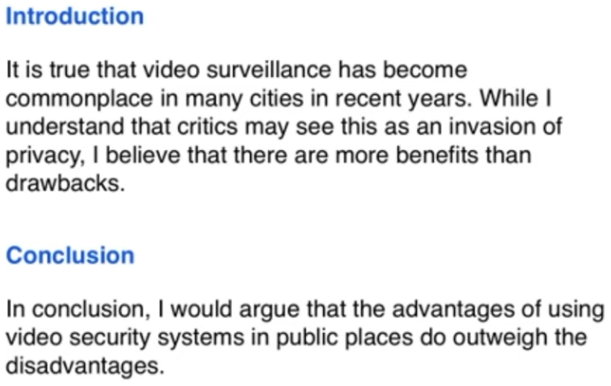
In conclusion, I would argue that the advantages of using video security systems in public places do outweigh the disadvantages.